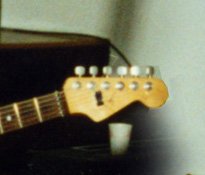stratamania
Mythical Status
- Messages
- 12,290
If you dig it, just go in album order from there.
Not quite my thing to go that far, I am more into jazz, rock, fusion and classical but interesting to know it is an actual band.

If you dig it, just go in album order from there.
You’d have to wait until Maladroit for any of that. There are quite a bit of tasty octaves but that’s about it. I had a similar thing with The Corrs. I saw them hidden on a CD-ROM of some kind (I thought it was Windows 95 but apparently not…) and didn’t realize they were a “real” band until years later.Not quite my thing to go that far, I am more into jazz, rock, fusion and classical but interesting to know it is an actual band.
A lot of their early stuff had deceptively simple progressions and really strange chord voicings. Always wished they would get back to that. Sometimes they flirt with it still.I never liked Weezer until I was made to learn their song "Buddy Holly" for a cover band. Such an interesting chord progression and such a great song as well.
Given that finding out the neck profiles at this point is very unlikely (apparently they were thicker than the very thin original Japanese neck) I think that neck is dead on for the red and the blue. Your thoroughness is impressive.
I’ve been wondering lately if the bridge pickup is original. There were Japanese Fender Contemporary Strats with vintage hardware but with a Dragster humbucker in the bridge, and I’ve seen them in torino red (bright red). I’m not sure the availability in the US, but apparently that pickup is very low output and chimey, so it could work. And they look right. A lot of people pull them from their Jaguar HHs, so you can still find them.
Those first two records are some of the best rock recordings of all time. They way Chris Shaw captured the guitars on the first album is pure magic. Dave Fridmann’s drum engineering on Pinkerton is a favorite of mine as well. I still get something out of most Weezer albums these days, but those first two are unbeatable.
It’s at this point that I recommend listening to “My Name Is Jonas,” you should instantly know if this is a rabbit hole you want to go down.
You’d have to wait until Maladroit for any of that. There are quite a bit of tasty octaves but that’s about it. I had a similar thing with The Corrs. I saw them hidden on a CD-ROM of some kind (I thought it was Windows 95 but apparently not…) and didn’t realize they were a “real” band until years later.
A lot of their early stuff had deceptively simple progressions and really strange chord voicings. Always wished they would get back to that. Sometimes they flirt with it still.
The furthest I’ve been able to go back is 1999, where the neck profiles were standard thin, boatneck, and the new fat neck. So I think it’s safe to assume it was the standard thin. Rivers has called the blue Strat a “copy” of the red, so it should be the same dimensions I would think.Yeah, I'm not sure what profiles were offered at the time, but this one is close to the standard thin. Not exact - more of a C/D shape and slightly thicker.
I did notice the red one has the incorrect nut width for the roller nut. You can see it's too narrow in some pictures. Guessing the nut is 43mm like the LSR, but the neck is 42mm.
Thanks - wanted to get it as close as possible. I did have the Pinkerton Tour Artwork (the black and white tape) on the previous version. Based on the Letterman 1995 performance.
That's interesting. Were they black uncovered humbuckers? I always assumed it was an E series Fender or Squier. I think there were Korean made ones in that finish, but they don't seem as common.
Yeah same here. There was an interesting Q&A with Chris Shaw a while back. Mainly stuff about the recording, but he also revealed additional equipment used and that the Mesa head was modified.
It's on the Windows 95 companion CD. I still have mine - best part is that some of the files are still readable (including the Buddy Holly video)
The furthest I’ve been able to go back is 1999, where the neck profiles were standard thin, boatneck, and the new fat neck. So I think it’s safe to assume it was the standard thin. Rivers has called the blue Strat a “copy” of the red, so it should be the same dimensions I would think.
Most of the examples I’ve seen of the Japanese super strats had black pickups and the humbucker was open. A lot of the newer ones you’ll find have covers though. The super strats are insanely complex. They had tons of options—multiple tremolo systems, top/rear routs, SSS/HSS/HH layouts, on and on. They were basically custom guitars that were at the dealer’s discretion. The interesting detail, though, is when the Fender factory closed down in 1985, it was the Contemporary or Boxer guitars that kept the company afloat until they could reopen. The vintage style guitars sold in the US were generally lower quality. It’d be hard to tell without seeing the original headstock (almost all of them were black).
From what I’ve been able to find, the pickup is very suited for that guitar. It has alnico magnets and is very low output. I saw someone measure theirs at 7.16k. In the videos I’ve found the overdriven tone has a thick, dry lower mid that really sounds right.
Here is a video of a Fender Boxer. Interestingly, the placement of the knobs line up with the red Strat, though the tortoiseshell pickguard is most likely a replacement.
Apparently the Japanese Fenders used (and still use) mainly Gotoh pickups, and I’ve found old listings where the Dragster was described as being made by Gotoh. It lines up pretty well spec-wise with the Gotoh HB-Classic (alnico 4, 7.67k), which you can buy from Amplified Parts for $40. It also sounds pretty good to my ears.
I think I saw that Q&A. Really great info, though he seemed understandably vague about his guitar mic choices. I think people make a lot of hay about the amp mods. Those early Boogies were all custom built so they’re each different, but most of them can get The Sound. Just not as quietly as one with a master volume. The Marshall SLX he also had was part of the puzzle as well.
Yeah, I’m definitely not saying anything for certain, but it is another option. I don’t know if DiMarzio had any low output humbuckers without their hex screw pole pieces at the time. I thought I’d consider some non-aftermarket options.Yeah that makes sense. I remember he said it was based off the red one - I think that was in a fairly recent interview from 2018 or so.
That’s tricky then. For what it’s worth, if you look at the Blue album “garage” picture, there’s the broken headstock on the floor. It was said to be from Rivers’ old Charvel, but it’s not black and it’s a Strat shape. It looks like there’s a logo, so it’s likely the original neck. Seems to have the black roller string trees, which would make sense.
I’ll have to see if I can find one to try. The original seemed to have gold pole pieces. Difficult to tell.
Interesting about the pickguard. Slightly different placement and material from the Warmoth ones. The only material that seemed to be a perfect match for the blue one was Allparts.
The earlier ones did vary. I’ve played/owned a few now, and only one got close to that sound in stock form.
I do think it was a modded amp. Possibly the factory FX loop mod - there are added jacks on the back. It’s more common to see this mod on the IIB. I’ve had it done before and it does change the sound.
Also, I found a guitar body for sale that has the correct hardtail bridge. Might be worth asking if the seller would be willing to offer it separately. I can send you the link if you're interested
Yeah, I’m definitely not saying anything for certain, but it is another option. I don’t know if DiMarzio had any low output humbuckers without their hex screw pole pieces at the time. I thought I’d consider some non-aftermarket options.
The color of the hardware is uncertain to be sure. In that Blue Album preproduction photo, the hardware is reflecting a light that is much warmer than the flash. Everything has to be zoomed in way more than is advisable. Photo film goes very pink or salmon in the highlights. The best pictures are on a dark stage under a red light. It really makes it hard to gauge.
I’m more of an enthusiast, nowhere near a professional musician, so I’ll defer to your experience with amps. I don’t want to be one of those guys on the internet. Rivers has tuned a lot of different amps to his voice, though. I think the tone on Maladroit is particularly good as well. But those first two amps were obviously very iconic. Both having two gain controls seems like a factor to me.
I appreciate that offer, but I’m currently dreaming about the red Strat. It’d be a very long term project in my case. But if you catch an extra Wilkinson nut I’d be very interested. That seems like the white whale out of everything.
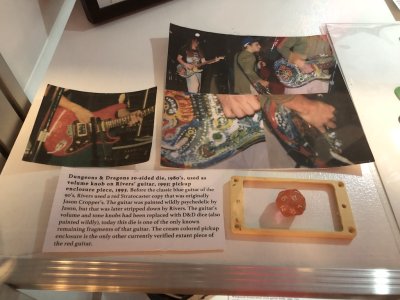
Thank you.Yeah, I never thought about it being a Fender.
That’s true. I don’t think there are any other pictures besides the few that we’re aware of.
Same here really. I generally go for a different sound than this, but the early Mesas still work very well for that. They’re tricky to adjust though - very different from most amps.
Sure, will certainly let you know if I find one. It’s the string guide that’s difficult to find. I’ve seen the roller nuts a few times.
I’m going to post some updates on the replica fairly soon. Just waiting on the neck pickup, which should be here next week.
Also, just thought I’d share this. They also had the blue guitar body on display.
View attachment 58665
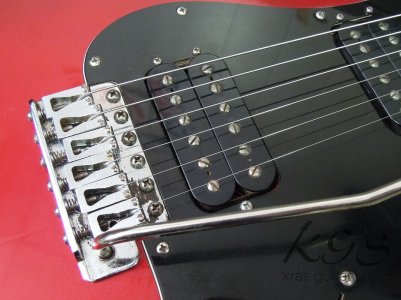
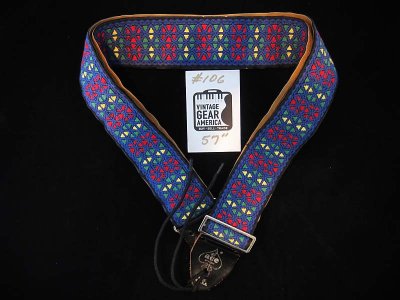
Thank you.
That’s awesome! Where is that?
Also, those saddles from the swirly paint era pin the bridge as part of a tremolo system called the Rox String Lock. It consisted of a locking string retainer, a two post bridge with hideous roller saddles, a six screw vintage bridge with those block saddles, and a locking steel tremolo block. I think it was only used on the Contemporary guitars, which were generally branded Squier.
View attachment 58667
Looking around, it looks like the chrome plating bubbles and flakes off easily, revealing a dark alloy. I think possibly the fulcrum area of the bridge was still painted even after the rest of the paint was scraped off to cover that up. It looks black with yellow screws early on, then yellow with chrome screws later.
It’s still not clear what the original pickup layout would have been. It could have been SSS, HSS, or HH. Probably one of the former two.
Disappointingly, the Ace Hootenanny strap that was used with the guitar seems to be devastatingly overpriced, due to some tenuous connection with Mick Taylor from The Rolling Stones. One sold for $700. I haven’t seen any reproductions.
View attachment 58668
EDIT: Bizarrely, it looks like the saddles are upside-down. Is that even possible?
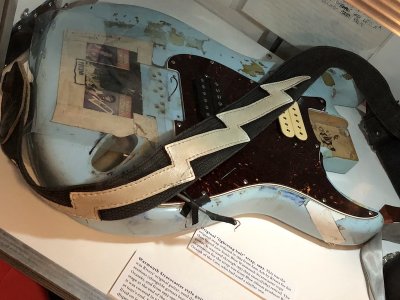
That’s really cool. A worthwhile investment, certainly.No problem.
That was before their show in NYC a few years back. There was a ticket upgrade available, which included a backstage tour with Karl (who showed us some of the current guitars) and a room with loads of memorabilia on display. Here’s the blue one:
View attachment 58685
That’s interesting. Those look like the correct saddles (other than being upside down) - maybe it’s one of the Squier Contemporary models then. Curious if the body is the same one used on the E series, but with HSH routing as standard.
I was wondering about that strap a while back. Good to know. I don’t think I’ve seen any repros exactly like it either.
That’s really cool. A worthwhile investment, certainly.
I could finally see that the yellow on the output joke and the white spots on the bridge pickup were leftover paint. That answered a lot of questions.
The Contemporaries only used the Rox system for part of 1983 and 1984, right before the E series I think. They seem to use roughly the same parts as the JV guitars of the time. They had some oddball variations. Pickups with various pole piece and mounting layouts, rear routing, pickguards with pickup rings, matching headstocks, matching necks, coil splits, etc. They even made some 24.75” scale guitars. There wasn’t much consistency with the line.
I’ve seen a few of the guitars with the pickguards off. They were all routed to fit the pickup layout.
Around the middle of 84 they switched to Schaller and Kahler locking trems. The vintage ones had stamped saddles but still had the locking trem block. So that narrows it down. It’s a bit older than I had thought.
I shouldn’t be, but I was surprised to see that there was a collector’s market for cheap guitar straps. I don’t think a vintage Ace is very usable anyway. The leather is so thin. Hopefully something turns up.
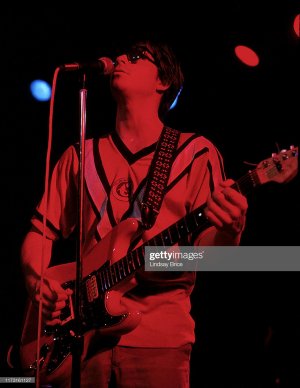
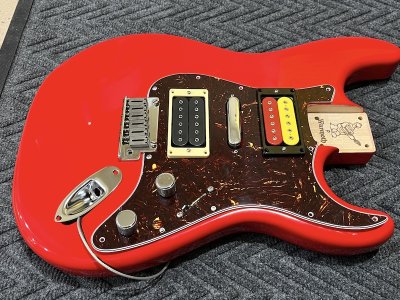
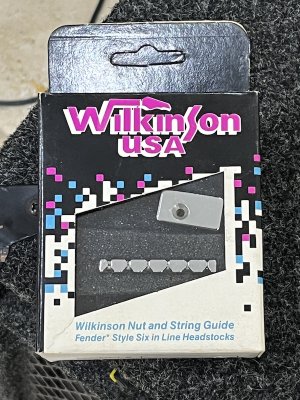
I thought the chrome hardware was reflecting something yellow in the picture of them recording, but now I see that the top of the bridge, the top screw in the jack plate, and the curved spot right above the output jack are painted yellow. Rivers probably didn’t bother cleaning the jack plate, or the white drips of paint on the bridge pickup, but the bridge plate is a little more confusing.Yeah, definitely.
That makes sense. I couldn't tell if it was paint or gold screws.
Any idea if they were basswood or alder? I've seen a few sources say alder, but nothing definitive. I recall the Fender Contemporary Strat (1985 I think) with the Kahler bridge that I once owned was basswood.
I went with basswood for the replica, since that's what the E series had. Still possible that it's one of those that was routed for HSH - especially if that headstock piece I mentioned earlier is the original neck (natural headstock)
Another clue is the neck joint. I'm not sure about the Contemporary models, but the late 80s E series had a neck pocket route that wasn't the standard depth. An aftermarket neck would likely end up sitting too high. I can't tell for sure if that's the case:
View attachment 58707
Might be the reason for the added pickup surrounds too.
Also, some progress on the replica. Almost done with the body half. The Humbucker From Hell is a new one. You can still special order them. I ended up going through Mike's Music Shop (banjomikez on eBay) and got them in a little under two weeks.
View attachment 58709
Here's the Wilkinson hardware - part number for the set is WNSS 2C
View attachment 58708
I thought the chrome hardware was reflecting something yellow in the picture of them recording, but now I see that the top of the bridge, the top screw in the jack plate, and the curved spot right above the output jack are painted yellow. Rivers probably didn’t bother cleaning the jack plate, or the white drips of paint on the bridge pickup, but the bridge plate is a little more confusing.
Everything I’ve seen about those particular Contemporaries says alder. But 1984 was a transition year, and the factory was pretty inconsistent, so I doubt they were all alder. I’ve seen photos of neck pockets that look just like basswood to me. I think you could justify either. I may just split the difference and get poplar.
Some of the neck pockets look a little shallow to me, so that’s a possibility. I’ve been finding most of my information from fuzzfaced.net, it’s a pretty good resource for different Strat models. Interesting that the surrounds may have been used as shims. Maybe that’s why some of the Contemporaries had them too.
Nice! Looking great so far. Do you prefer the two post bridge, or was that to use narrow saddles? What pickup did you settle on for the bridge?
Yeah, you can see the paint splotches in a lot better detail in the picture you took. It looks like he cleaned up the flat part of the jack plate but not any of the curves, which lends credence to him using a razor blade (for anyone who wants to go full relic I suppose).If it appears to be yellow in the earlier pictures, then it’s likely leftover paint.
That’s what I was thinking. From what I’ve seen, it was the higher end Fenders (ST-62 etc) that remained alder until the early 90s.
Yeah, that seems to be a good resource. The Dimarzio pickups generally include surrounds - possible that they were used for no specific reason. Jason described how he and Pat tried to add as many modifications possible - coil split, different pickups, etc.
Thanks - no real reason. I figured it would never be exact and would be set flat against the body anyway. Only downside is that there are limited options for saddles, but maybe there’s an aftermarket plate that has the screws centered.
Bridge pickup is a Super Distortion. I thought I’d at least give it a try, since the original didn’t seem to have a Seymour Duncan. If that doesn’t work, I’ll see if I can find one of the Fender humbuckers.
Also, I don’t think I went into detail about this before - but here’s a thought on the wiring…The middle pickup I used is from a 1988 US Telecaster I used to have. Likely the same pickup Jason’s Telecaster had.
They’re braided 2-conductor with a teflon inner wire… so they can’t be soldered to the back of a pot, otherwise the inner wire melts and shorts out, resulting in no sound from the middle pickup. This is exactly what happened - but I’ve left it for now, as I suspect the original had the exact same error:
Switching between pickups right before the song starts, but no sound from the middle.
Yeah, you can see the paint splotches in a lot better detail in the picture you took. It looks like he cleaned up the flat part of the jack plate but not any of the curves, which lends credence to him using a razor blade (for anyone who wants to go full relic I suppose).
That’s an interesting detail about the surrounds. I think possibly Rivers added them, but it’s hard to see the old pickguard in any detail. He seems to like the clashing colors, so it makes sense that they were thrown on just because they were around.
I’ve been collecting info on six screw trems with vintage screw spacing and narrow string spacing. I’m still leaning toward PRS saddles, which have 52.5mm string spacing. 4mm difference seems like it’d cause stability issues. Fender Highway One bridges are ~53mm. Callaham and Ping (via Stratosphere Parts) have them as well. Kluson and Wilkinson both make bridges that are ~54mm.
It’ll be interesting to hear what you think of the pickup when it’s playable. I’m picturing a low output pickup with a lot of high end, but I may be completely off. Especially considering how bright the neck pickup was, there might be no bridge to speak of on the record. Chris Shaw has mentioned that he didn’t like that Jason used his neck pickup, but nothing about Rivers that I’ve seen. But if it was a Dimarzio it’d surely be high output ceramic.
That’s interesting. Are you talking like a PAF-style shielded wire? Would the proper way to solder it be to pull the shielding back and roll it into a wire shape like an XLR cable? I’ve heard the dropout in the intro to that song before, but didn’t think about what caused it. That’s compelling.
If people get as interested in making red strat replicas as they do blue strats, I think this thread will be a very valuable resource. I wanted to take the opportunity to suggest these guitars be called Cuoppercasters.
The Humbucker From Hell seemed to be a big hit early on, with tons of superstrat guys replacing their neck single coils. Interestingly, the lower coil is higher output than the upper coil. It has less winds with lower gauge wire, so apparently it sounds the same. Wonder which one was used for the coil split. I have a hard time seeing what Jason is playing in that video but I’ll try to look.I see what you mean. Yeah that's possible, though it did have the red/yellow pickup when it was painted. Interestingly the pickup was already installed in 1991 (see The Answer Man from VCD) and Dimarzio claims that was the year it was released. Must have been one of the first if that's the case.
Do any Wilkinson bridges resemble it? The string guide packaging mentions that they were intended for use with the VS100, but that's definitely not it.
Yeah I've heard the same thing. Jason described the split neck pickup as an "AM radio sound" - will definitely post some thoughts once it's completed. Just waiting on the neck to have the nut fitted.
I think high output is possible. If you listen to the bridge for the Say It Ain't So isolated guitar, the resonating springs can be heard. So it's likely the red guitar anyway.
Basically, but with teflon for the inner wire instead of cloth. Usually it's fine to solder the entire wire to the back of a pot, but in this case, it might be better to strip some of the outer braid and ground separately.
Definitely. I'll try to do a proper write up like the Cuomocaster post. Will certainly credit you and link to this thread as well.
The Humbucker From Hell seemed to be a big hit early on, with tons of superstrat guys replacing their neck single coils. Interestingly, the lower coil is higher output than the upper coil. It has less winds with lower gauge wire, so apparently it sounds the same. Wonder which one was used for the coil split. I have a hard time seeing what Jason is playing in that video but I’ll try to look.
The bridge looks original to me. Every Wilkinson bridge I’ve seen has a stamped logo on it somewhere, and a black delrin insert for the whammy bar. The intonation screws look bent, but the saddles could have been left with big gaps too. I think possibly the bridge and wiring are what ultimately led to it being given away and ritually destroyed. It’s possible that the mounting screws were still yellow and the black paint was wearing off the bridge or the chrome had come off showing the dark bare metal. This is probably an unimportant detail to try to figure out.
Awesome. Exciting moment of truth there. How is the nut installed? Do you glue it or screw it in? Are you going to leave the Tele pickup shorted or get it working?
Nice, I’ll keep an eye out for that. Thanks!
I heard that about Rage Against The Machine. Some of those early influences are pretty wild, like how buying the Mesa made Rivers start playing like Carlos Santana. You can still kind of hear it in the Blue era solos.Apparently they were going for the Rage Against The Machine sort of sound.
That’s interesting. The dealer said they were both the same. I can only assume Jason wired it up per the diagram.
The early DP156 came in red/yellow as standard, with the wire coming out from the yellow coil (installed closest to the neck in this case)
If you end up ordering a new one, remember to specify you want the wire coming out from the side with the yellow coil.
Yeah, the bridge might remain a mystery unless we find some better pictures. I’ll be happy if I can get the sound and overall look accurate enough. It was never going to be as close as the blue one, since it doesn’t have the correct body to begin with. The E-series Fenders have become pretty expensive now, so it would be a waste to just buy one for the body only.
From what I understand, the nut slot needs to be cut slightly wider and then it’s screwed in. I’m likely going to disconnect it completely and just leave it for show.
I’m also wondering if he used the tone control at times. The beginning of the build up during Only In Dreams (around 5:20) sounds sort of like a tone control rolled off.
Sure, I’ll let you know. Also, check your private messages - I found something that might be of interest.
I heard that about Rage Against The Machine. Some of those early influences are pretty wild, like how buying the Mesa made Rivers start playing like Carlos Santana. You can still kind of hear it in the Blue era solos.
That might not be true across the board, it’s just what I found in my research. You should be able to look at the coils and see if one is thicker than the other. I think it’s supposed to kill less of the high end when bucking hum.
I’ll keep that in mind. I saw on the DiMarzio site that you can email them for custom color combos for $10 extra, I’ll probably try that.
I’m hoping more pictures surface someday soon. Karl, Jason, and Chris Shaw were apparently taking tons of photos during recording, and the former two have talked about going through them, but who knows when that’ll happen. Doesn’t seem appropriate to pester anyone about them. The interesting thing about this project versus a blue Strat is how much of it is up to interpretation. It’s more of an art project. Pretty fun. Lots of bad info about the blue still out there too though. Yours is probably the best I’ve seen.
He might have used his pick to turn the tone knob. That may have been the Les Paul Special track possibly. I think he generally used the neck pickup on the Strat and the bridge on the LPS, and that part sounds bridge-y to me. They’re both super thick so it’s hard to tell.
Cool, thanks!
